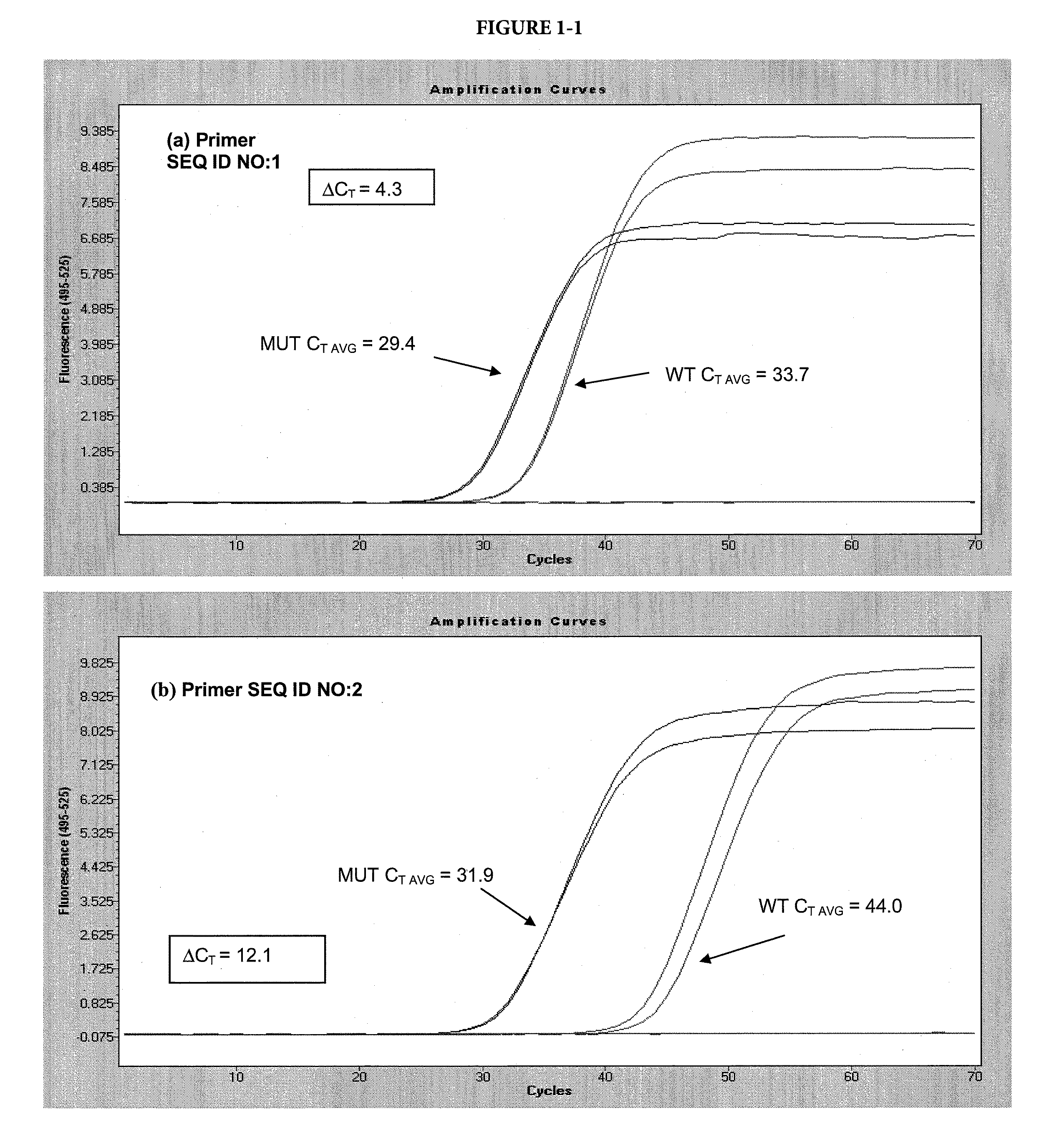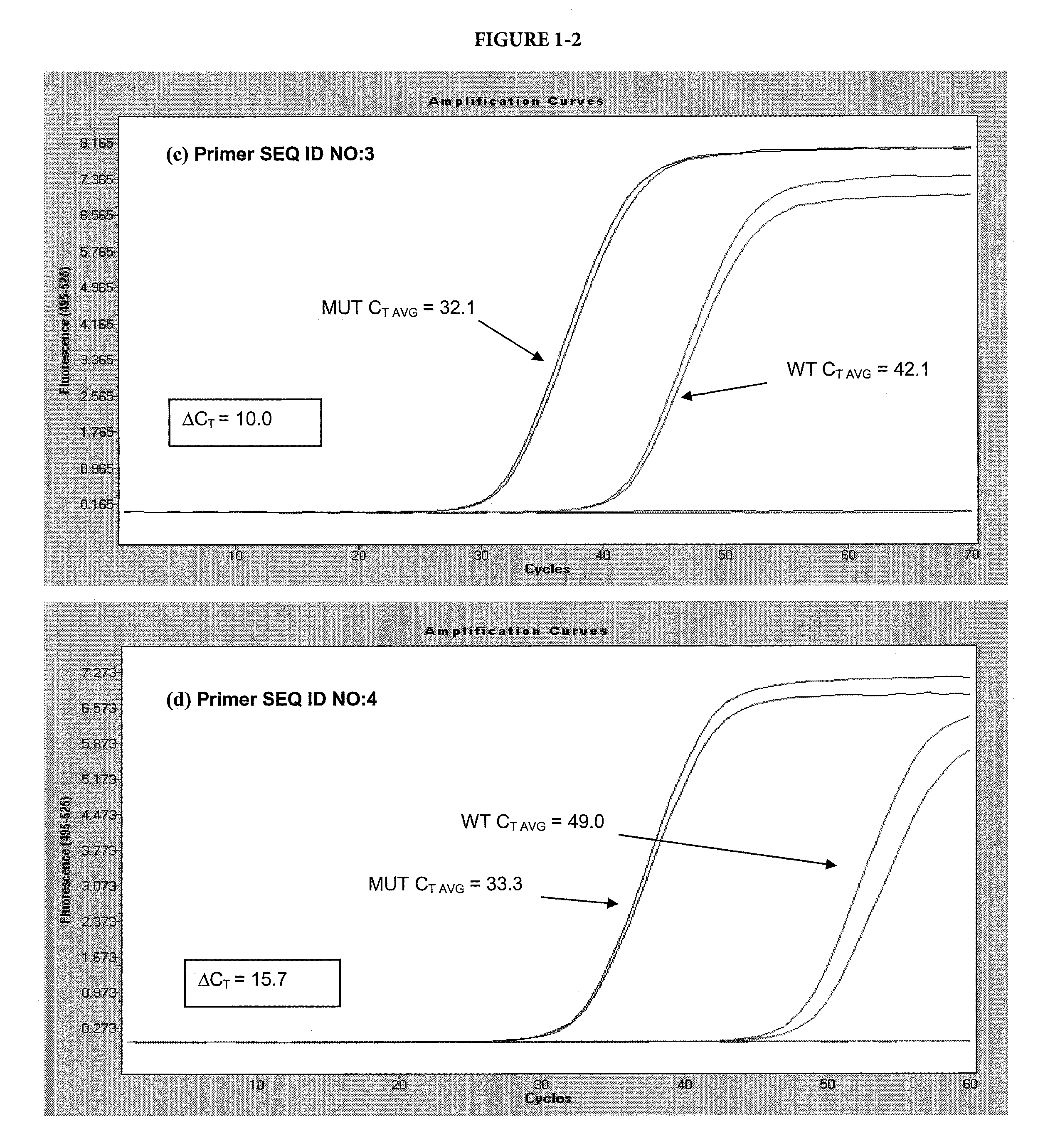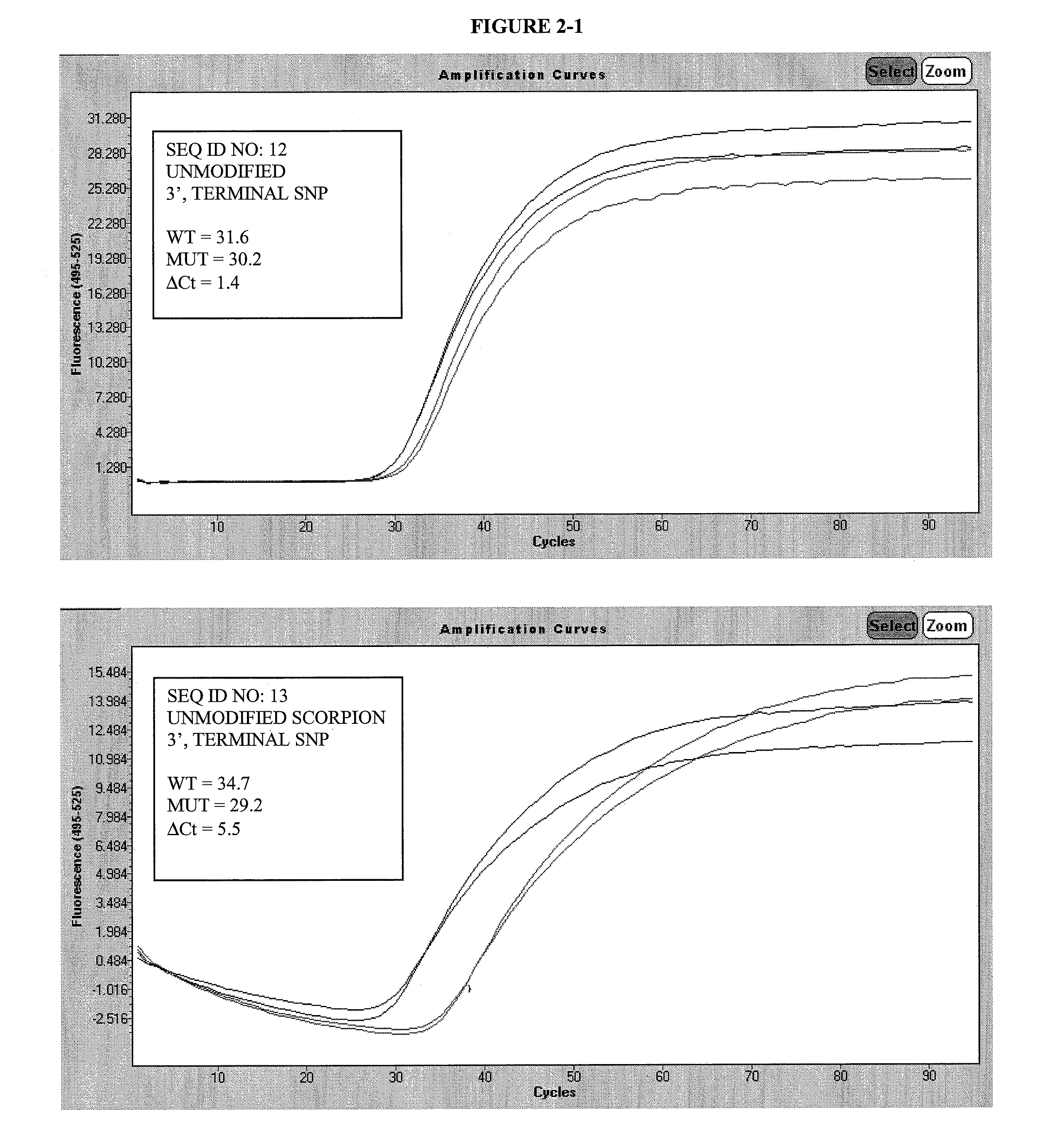Allele-specific amplification of nucleic acids
a technology of alleles and nucleic acids, applied in the field of allele-specific amplification, can solve the problem of lack of specificity of pcr
- Summary
- Abstract
- Description
- Claims
- Application Information
AI Technical Summary
Benefits of technology
Problems solved by technology
Method used
Image
Examples
example 1
Allele-Specific Amplification Using a Primer with an Internal Selective Nucleotide
[0092]In this example, two variants of the template sequence were used: a matched variant, with a sequence complementary to the selective nucleotide in the allele-specific primer and a mismatched variant, with a sequence non-complementary to the selective nucleotide in the allele-specific primer. The matched variant was a plasmid DNA with the insert representing the BRAF sequence with a V600E mutation. The mismatched variant was the same plasmid with the BRAF wild-type sequence. The forward primers (SEQ ID NO: 1-4) and reverse primer (SEQ ID NO: 11) are shown in Table A. The forward allele-specific primers were designed with the selective nucleotide internal of the 3′ terminus, at the N-2 position. Some primers contained chemical modifications where indicated.
[0093]Each 50 μL reaction contained 105 copies of either target, 8% glycerol, 50 mM tricine (pH 7.7), 45 mM potassium acetate (pH 7.5), 200 μM ea...
example 2
Allele-Specific Amplification Using Primers with an Internal Selective Nucleotide and Different Nucleic Acid Polymerases
[0096]In this example, the same matched (mutant) and mismatched (wild-type) targets as in Example 1 were amplified using primers shown in Table A. Amplification was carried out in the presence of Z05, ΔZ05, or ΔZ05-Gold polymerase.
[0097]All reactions were done in triplicate, in 15 μL volumes containing 105 copies of either target, 200 μM each dATP, dCTP and dGTP, 400 μM dUTP, 0.1 μM forward primer, 0.7 μM reverse primer, 2 μM Syto-13 intercalating dye, 1% DMSO, 0.04 U / μl uracil-N-glycosylase (UNG), and 3 mM magnesium acetate. Z05 reactions contained 3 U of polymerase, 130 mM potassium acetate (pH 7.5), 5% glycerol, and 50 mM Tricine (pH 8.3). ΔZ05 reactions contained 3 U of polymerase, 25 mM potassium acetate (pH 7.5), 5% glycerol, and 50 mM Tricine (pH 8.3). Δ05-Gold reactions contained 15 U of polymerase, 45 mM potassium acetate (pH 7.5), 8% glycerol, and 50 mM ...
example 3
Allele-Specific Amplification Using Scorpion ARMS-Like Primers with Internal Base Modifications and / or Internal Selective Nucleotide
[0101]
TABLE 3 SEQ IDFUNCTIONPRIMER SEQUENCE12FORWARDAGTAAAAATAGGTGATTTTGGTCTAGCTACAGAPRIMER13FORWARDFCCCGCGCGGACCCACTCCATCGAGAGCGCGGGPRIMER,QJAGTAAAAATAGGTGATTTTGGTCTAGCTACACAPROBE14FORWARDAGTAAAAATAGGTGATTTTGGTCTAGCTACYGAPRIMER15FORWARDFCCCGCGCGGACCCACTCCATCGAGAGCGCGGGPRIMER,QJAGTAAAAATAGGTGATTTTGGTCTAGCTACYGAPROBE 6FORWARDGTAAAAATAGGTGATTTTGGTCTAGCTACAGAGPRIMER16FORWARDFCCCGCGCGGACCCACTCCATCGAGAGCGCGGGPRIMER,QJGTAAAAATAGGTGATTTTGGTCTAGCTACAGAGPROBE 9FORWARDGTAAAAATAGGTGATTTTGGTCTAGCTACYGYGPRIMER17FORWARDFCCCGCGCGGACCCACTCCATCGAGAGCGCGGGQPRIMER,JGTAAAAATAGGTGATTTTGGTCTAGCTACYGYGPROBE11REVERSETAGCCTCAATTCTTACCATCCACAXPRIMERS18PROBEFTCTCGATGGAGTGGGTCCQpX-N6-benzyl-dAY-N6-para-tert-butyl-benzyl-dAF-cx-FAM donor fluorophoreQ-BHQ-2 “Black Hole” quencherJ-HEGp-3′-phosphate*The allele selective nucleotide is underlined (N or N-1 position from 3′ terminus)
[010...
PUM
| Property | Measurement | Unit |
|---|---|---|
| pH | aaaaa | aaaaa |
| pH | aaaaa | aaaaa |
| temperature | aaaaa | aaaaa |
Abstract
Description
Claims
Application Information
 Login to View More
Login to View More - R&D
- Intellectual Property
- Life Sciences
- Materials
- Tech Scout
- Unparalleled Data Quality
- Higher Quality Content
- 60% Fewer Hallucinations
Browse by: Latest US Patents, China's latest patents, Technical Efficacy Thesaurus, Application Domain, Technology Topic, Popular Technical Reports.
© 2025 PatSnap. All rights reserved.Legal|Privacy policy|Modern Slavery Act Transparency Statement|Sitemap|About US| Contact US: help@patsnap.com



